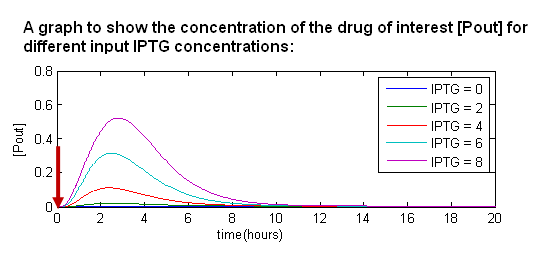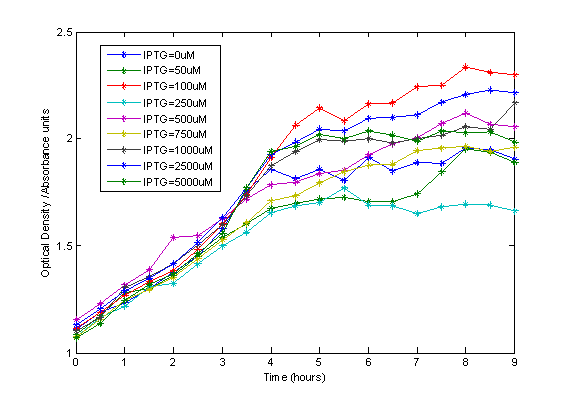Team:Imperial College London/M1
From 2009.igem.org
(→Our results) |
(→Our results) |
||
| Line 56: | Line 56: | ||
[[Image:II09_IPTG_growth1.jpg|right|400px]]<br> | [[Image:II09_IPTG_growth1.jpg|right|400px]]<br> | ||
Different concentrations of IPTG were added to a 96-well plate [link to assay] of e-coli Top 10 cells containing LacI-RFP genetic constructs. Here we measured the optical density of the cells over-time, for different concentrations of IPTG to monitor the effects in the culture. The IPTG growth curve results are plotted in the figure (ADD A FIGURE CAPTION TO IT: FIG1, FIG2 ETC). | Different concentrations of IPTG were added to a 96-well plate [link to assay] of e-coli Top 10 cells containing LacI-RFP genetic constructs. Here we measured the optical density of the cells over-time, for different concentrations of IPTG to monitor the effects in the culture. The IPTG growth curve results are plotted in the figure (ADD A FIGURE CAPTION TO IT: FIG1, FIG2 ETC). | ||
| - | By visual assessment,the growth rate of the culture prior the saturation phase stays within a narrow range and does not change significantly with concentrations of [IPTG]. Therefore, we can conclude that [IPTG] in the concentration ranges we are using does not affect cellular growth and is non toxic. The effects of IPTG have been widely studied [SAY THAT WE ARE CONFIRMING SOMETHING WELL KNOWN ANYWAY BY OTHERS] | + | By visual assessment,the growth rate of the culture prior the saturation phase stays within a narrow range and does not change significantly with concentrations of [IPTG]. Therefore, we can conclude that [IPTG] in the concentration ranges we are using does not affect cellular growth and is non toxic. The effects of IPTG have been widely studied [SAY THAT WE ARE CONFIRMING SOMETHING WELL KNOWN ANYWAY BY OTHERS]<br> |
<u>Drylab</u> | <u>Drylab</u> | ||
Taking into account the indications from the wetlab, we can then draw a relationship between different input IPTG concentrations and the amount of polypeptide produced. | Taking into account the indications from the wetlab, we can then draw a relationship between different input IPTG concentrations and the amount of polypeptide produced. | ||
| Line 62: | Line 62: | ||
*When the effects of IPTG wear off, the system returns to equilibrium. | *When the effects of IPTG wear off, the system returns to equilibrium. | ||
*The more IPTG we add in, the higher the amount of output protein. | *The more IPTG we add in, the higher the amount of output protein. | ||
| - | [[Image:II09_SIm_main_prot.jpg]] | + | [[Image:II09_SIm_main_prot.jpg]]<br> |
FROM THE BOTTOM ONWARDS WE MAY NEED TO SHORTEN OR ADD SOME STUFF TO LEARN MORE TABS. | FROM THE BOTTOM ONWARDS WE MAY NEED TO SHORTEN OR ADD SOME STUFF TO LEARN MORE TABS. | ||
Revision as of 00:10, 18 October 2009

Contents |
Module 1: Protein Production
Overview
The E.ncapsulator has been designed to produce and deliver polypeptides (amino acid polymers) to the intestine. Here in our system, a single gene is responsible for producing them. In order to perform this function successfuly, the polypeptide must be synthesised at a rate that will be sufficient to facilitate its accumulation inside the cell. Once the culture has grown to an optimal level, polypeptide production is chemically induced using IPTG [ref IPTG induction]. With our generic design, it is possible to synthesise any polypeptide. In our project, we have focused on:
- PAH (phenylalanine hydroxilase): Include an explanation
- Cellulase: Include an explanation
- Opiorphin: Include an explanation
Genetic circuit
 ADD MORE DETAILS ABOUT GENETIC CIRCUIT AND LITERATURE REVIEW OF GENES. OTHER STUFF HAS MOVED TO DETAILS OF GENETIC CIRCUIT PG. GET CHARLES TO UPLOAD THE GEN.CIRCUIT VIDEO.
This is the genetic circuit responsible protein drug fabrication (Module 1).
ADD MORE DETAILS ABOUT GENETIC CIRCUIT AND LITERATURE REVIEW OF GENES. OTHER STUFF HAS MOVED TO DETAILS OF GENETIC CIRCUIT PG. GET CHARLES TO UPLOAD THE GEN.CIRCUIT VIDEO.
This is the genetic circuit responsible protein drug fabrication (Module 1).
LacI is produced constitutively by the E. coli bacterium, and it represses the pLambda promoter. This inhibits production of the proteins of interest (PAH and cellulase).
To start the drug manufacturing process, IPTG is pipetted into the system. IPTG will repress LacI. As a result, protein production is de-repressed. Then, the enzymes PAH or cellulase will be produced by the E.ncapsulator.
Polypeptide Showcase
To demonstrate The E.ncapsulator's versatility, we have chosen to showcase it with both enzymes and peptides. These two classes of polypeptide have very different properties that we have considered and catered for in The E.ncapsulator's design.
 About the difference between enzymes and peptides.
About the difference between enzymes and peptides.
AFTER THIS: I HAVE ADDED ANOTHER SECTION FOR RESULTS AND DRYLAB, TO STANDARDIZE.
Our results
Wetlab
Different concentrations of IPTG were added to a 96-well plate [link to assay] of e-coli Top 10 cells containing LacI-RFP genetic constructs. Here we measured the optical density of the cells over-time, for different concentrations of IPTG to monitor the effects in the culture. The IPTG growth curve results are plotted in the figure (ADD A FIGURE CAPTION TO IT: FIG1, FIG2 ETC).
By visual assessment,the growth rate of the culture prior the saturation phase stays within a narrow range and does not change significantly with concentrations of [IPTG]. Therefore, we can conclude that [IPTG] in the concentration ranges we are using does not affect cellular growth and is non toxic. The effects of IPTG have been widely studied [SAY THAT WE ARE CONFIRMING SOMETHING WELL KNOWN ANYWAY BY OTHERS]
Drylab
Taking into account the indications from the wetlab, we can then draw a relationship between different input IPTG concentrations and the amount of polypeptide produced.
- When we introduce IPTG into the system, it temporarily removes LacI from the system. Hence, during this period of time, we produce the drug of interest.
- When the effects of IPTG wear off, the system returns to equilibrium.
- The more IPTG we add in, the higher the amount of output protein.

FROM THE BOTTOM ONWARDS WE MAY NEED TO SHORTEN OR ADD SOME STUFF TO LEARN MORE TABS.
Enyzme Production
One of the challenges involved in enyzme production is the need for resistance to the proteases found within the small intestine. Although The E.ncapsulator is capable of delivering the enyzmes safely through the harsh environment in the stomach, upon release into the small intestine, the cells would be susceptible to breakdown by the proteases naturally found in the gut environent. For this reason, we have used protease resistant forms of the enyzmes to be produced.
We have chosen two enzymes to showcase The E.ncapsulator's protein production module.
These are:
- Cellulase - an enzyme that breaks down the tough fibrous molecule cellulose into cellobiose. Cellulose is not digested by the human body and is commonly referred to as dietary fibre. Cellulose is made up of repeating units of glucose molecules, and as such, is a large store of energy. Also, cellulose can form viscous gel-like structures that trap starch, proteins and fats which would otherwise be accessible to the animal's digestive enzymes and transport systems. By using The E.ncapsulator to deliver cellulase to the gut, we hope that more nutritional value can be obtained from food consumed. In doing this we could reduce levels of malnutrition around the world.
- Phenylalanine Hydroxylase - an enzyme that breaks down the amino acid phenylalanine into tyrosine. A deficiency or defective PAH enzyme results in a condition called phenylketonuria. This enzyme deficiency results in the accumulation of phenylalanine in the blood, which can result in serious problems such as seizures and mental retardation. By using The E.ncapsulator's unique drug delivery mechanism, we hope that by delivering PAH into the small intestine, we can relieve people of this condition.
Peptide Production
The delivery and production of short chain peptides is a different challenge altogether. All peptides when synthesised always start with the amino acid methionine. If synthesised directly, this can mean that the peptide no longer has the same bioactivity. The body naturally has a mechanism by which larger polypeptides are degraded into smaller functional peptides. Using this mechanism, we have designed a universal adapter for short chain peptide production and delivery, by which any peptide can be produced and delivered to the gut. To demonstrate this, we have chosen to showcase a short chain peptide, opiorphin:
- Opiorphin - is a small pentapeptide (5 amino acids) that is naturally produced by the body, and plays a role in pain relief and as an anti depressant. By delivering this small peptide into the gut, we hope to offer a natural alternative to the other more addictive drugs.
Module 1 is chemically induced by the addition of IPTG. This makes up part of the temporal control module, under the chemical induction section. After sufficient amount of protein of interest has been produced, autoinduction occurs and encapsulation will start.
Project Tour


 "
"










